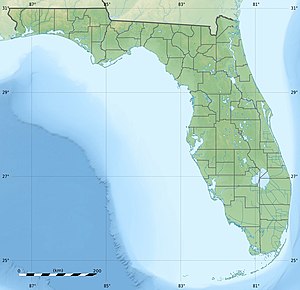Ten Thousand Islands
| Ten Thousand Islands National Wildlife Refuge | |
|---|---|
IUCN category IV (habitat/species management area) | |
 Beach shore line and vegetation | |
| Location | Collier County, Monroe County, Florida, United States |
| Nearest city | Goodland, Florida |
| Area | 35,000 acres (140 km2) |
| Established | 1996 |
| Governing body | U.S. Fish and Wildlife Service |
| www | |

The Ten Thousand Islands are a chain of islands and mangrove islets off the coast of southwest Florida, between Cape Romano (at the southern end of Marco Island) and the mouth of Lostman's River. Some of the islands are high spots on a Submergent coastline. Others were produced by mangroves growing on oyster bars.[1] Despite the name, the islets in the chain only number in the hundreds.[citation needed]
Geography
The northern part of the Ten Thousand Islands, between Cape Romano and Everglades City, is in the Ten Thousand Islands National Wildlife Refuge.[2] The southern part of the Ten Thousands Islands, south of Everglades City, is in Everglades National Park.[3] The 99-mile long Wilderness Waterway begins at Everglades City and ends at Flamingo at the southern tip of the Florida peninsula.[4] Administrative control of the islands is split between Collier County and Monroe County.
Archaeology
The Ten Thousand Islands were used and occupied by Native Americans for thousands of years. Evidence of former living sites can be found under as much as four feet of water.[5] A number of shell rings and other shell complexes have been identified in or adjacent to the Ten Thousand Islands.[6] The Horr's Island archaeological site at the northern end of the Ten Thousand Islands was occupied year-round 3,500 years ago, and other sites are presumed to have been inundated by a rise in sea level.[7] The material culture of the Indians living in the Ten Thousand Islands was distinctive enough to be classified as at a least a sub-area of the Glades culture area.[8]
Demography
Almost all of the Ten Thousand Islands are currently uninhabited. The largest, Chokoloskee Island, which is connected to Everglades City by a causeway, has about 400 permanent residents. Other islands have been sporadically inhabited in the 19th and 20th centuries by individuals or families.[9]
Recreation
Some of the Ten Thousand Islands are suitable for overnight visits, as dictated by the United States Fish and Wildlife Service. Since this is a wilderness area where wind, weather and lack of fresh water can become threatening, the Wildlife Service recommends only seasoned canoeists and sea kayakers attempt the trip. The southern tip has become a prime destination for snorkeling and water sports vacations.
See also
References
- ^ Tebeau:29-30
- ^ "Ten Thousand Islands National Wildlife Refuge". U.S. Fish and Wildlife Service. Retrieved 5 June 2011.
- ^ "Ten Thousand Islands". National Park Service. Retrieved 5 June 2011.
- ^ "Gulf Coast Trails". National Park Service. Retrieved 5 June 2011.
- ^ Tebeau:29-30
- ^ Schwadron, Margo (2010). "Landscapes of Maritime Complexity: Prehistoric Shell Works sites of the Ten Thousand Island, Florida". University of Leicester. Retrieved 8 December 2011.
- ^ Milanich:85
- ^ Milanich:277
- ^ Tebeau:81-82
- Milanich, Jerald T. (1994). Archaeology of Precolumbian Florida. Gainesville, Florida: University Press of Florida. ISBN 0-8130-1273-2.
- Tebeau, Charlton W. (1968). Man in the Everglades. Coral Gables, Florida: University of Miami Press.
![]() This article incorporates public domain material from websites or documents of the United States Fish and Wildlife Service.
This article incorporates public domain material from websites or documents of the United States Fish and Wildlife Service.
External links
Ten Thousand Islands.


